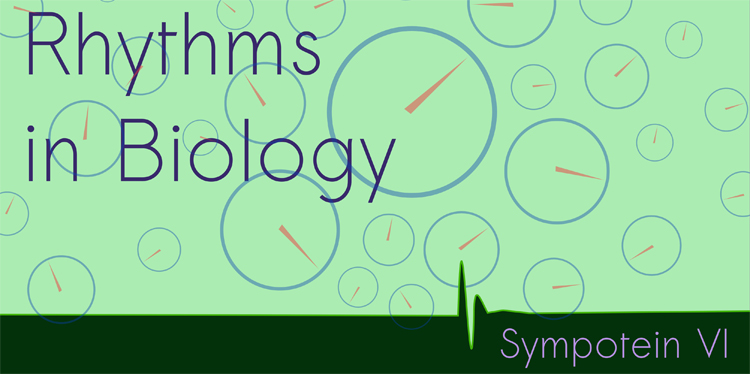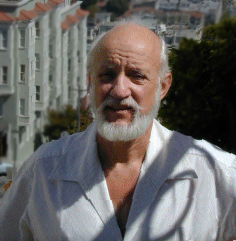Sympotein Six: Rhythms in Biology
NCBS prides itself on the interdisciplinarity of its biology. Investigations in more traditional areas are enriched by contributions from researchers with strengths in physics, mathematics, informatics, chemistry and nanotechnology. The benefits of such cross-fertilisation were exemplified last year when a DNA-based pH probe developed by Yamuna Krishnan’s nanobiology team was quickly shown to actually work in living cells in collaboration with Jitu Mayor’s team. (see Nature News article).
Over the last two years NCBS has been encouraging an interdisciplinary perspective by a more-or-less regular series of symposia organised by students, junior research fellows and postdocs. By design they are called “Sympoteins” (the Greek root for the word symposium, meaning “to drink together”) to remind us of the benefits of discussion that occurs in a less formal setting. To maximise the likelihood of us all being drawn out of our comfort zone, each Sympotein should focus on a topic that is not already being pursued at the Centre. So far there have been six Sympoteins, delving into such diverse areas as non-coding RNAs, biological symmetry, and the evolution of sex.
To anyone who has attended one, the extent to which the Sympotein presenters have mastered their newly-explored topics is very impressive. And for the participants, the desired benefits have often been delivered. NCBS alumnus Gautam Dey, who helped organise several of the early Sympoteins, says: “I think we definitely broadened our scientific horizons by diving into new, unrelated areas of research. More than that though, I think it was a very interesting collaborative exercise because we all sat together through multiple practice rounds -often without the faculty advisor- trying to polish and finesse each other's talks. Those sessions were where I felt we learnt the most.” And I hear at least some of these discussions were gainfully fuelled, as in the Greek originals, by the odd libation or two.
Sympotein Six, which was held just last week, was in large part a testament to the legacy of an interdisciplinarian non pareil: the late US scientist Art Winfree. Winfree’s talents and interests ranged over a vast intellectual domain, as evidenced by the honours he garnered in disparate fields: a Macarthur Foundation “genius grant” for theoretical biology, the Einthoven Prize for his work on ventricular fibrillation, and the Norbert Wiener Applied Mathematics Prize of 2000. Two themes ran through all of Winfree’s work: understanding biological rhythms - the focus of the Sympotein - and looking at questions through the prism of his mathematical specialty: topology, the mathematics of spaces.
As covered in the Sympotein, biological rhythms fit into several general categories. The most fascinating type is where identical or near-identical members of a system all do something in unison. Examples of this include the synchronous beating of cardiac muscle cells, the coordination of movement in bird flocks and fish schools, and the massed flashing of male Asian fireflies. Strogatz, in a TED talk on synchronization, provides a very direct experience of it: asking the audience to applaud in time, they quickly slip into lock-step, a well-known spontaneous phenomenon of concert halls. Each individual starts by clapping to their own rhythm, and each can be modelled, as Winfree did, as an oscillator undergoing simple harmonic motion. But each person is also aware of the rhythms of nearby audience members, and together with a psychological tendency to conform, this provides what is technically known as “weak coupling”. Winfree showed that as long as there is weak coupling, and the initial rhythms of the individual members of a system do not vary too much, then synchronisation is mathematically inevitable.
As detailed in the Sympotein talk by Rohini Ramdas, Winfree also discovered a very unexpected feature of synchronicity: that it could find itself at the mercy of a mathematical singularity. What is a singularity? Rohini put it this way: “it is a point or a set of points at which bad things happen”. A helpful example of a generic (non-synchronicity-related) singularity is either of the earth’s Poles, considered in relationship to our modern system of time zones. These time zones are defined in relation to the meridians of longitude, but since all the meridians converge at each Pole, at these points the relationship breaks down completely. Similar breakdowns can occur in synchronous systems whose rhythmic nature is fine-tuned by factors outside the system. Such fine-tuning is very common: various rhythmic aspects of human physiology - breathing, the wake-sleep cycle, the heartbeat - can be modulated by many internal and external factors such as hormone levels, exposure to light and nervous input. Our wake-sleep cycle for example depends on an internal biological clock that has no inherent “idea” of daily light-dark cycles and must be aligned with them via exposure to bright light. The two rhythms, internal and external, are then said to be “in phase”. If the phasing of any internal rhythm can be modulated, in a graduated way, by the strength of an external factor, then Winfree showed that the following is mathematically inevitable: At some given combination of factor strength (e.g. period of exposure to light) and the position (or phase) of the internal cycle at which the factor is applied, the coupling of the internal oscillators that make up the internal clock will break down and the clock will stop. Having blazed a new mathematical trail to prove this remarkable fact was not enough for Winfree. With extraordinary versatility, he immediately devised an elegant experiment (on the modulation of fruitfly development by light) that actually demonstrated a biological clock gone down. Winfree's ideas, including those just outlined, are now very much part of the framework of understanding how critical human rhythms such as the breathing of an infant, and the pumping of the heart, can suddenly fail.
Art Winfree’s remarkable contributions to our understanding of biological rhythm demonstrate the benefits of an interdisciplinary approach, but in a rather atypical way. He embodied so many diverse talents that he could do important cross-disciplinary work on his own, a fertile collaboration as it were of his mathematical and biological selves. The more common form of collaboration in biology, however, is of course between individuals or teams with different skill sets. Such collaboration is not always easy. While nonscientists might see all scientists as quite similar, there are often strong “cultural differences” between, for example, theoreticians and experimentalists. A Sympotein is a wonderful opportunity for learning how to set aside the preconceptions we may have about those who do a different type of science.
But interdisciplinary barriers are more likely to be broken down if the Sympoteins retain a sense of adventure and fun. In seeking feedback for this article, the greatest enthusiasm for the event was shown by participants of the earlier editions. Now, for whatever reasons, perhaps it is coming to feel more like a duty, than a platform for creativity. I was delighted to read what Steven Strogatz considered to be the most "valuable lesson" Winfree had taught him about doing science: ‘The important thing, he said, was for us to choose a problem that "irrationally grips you (and me) by the imagination, else nothing remarkable can be expected to happen."’ A Sympotein, by its very definition, should never be too rational.


Comments
Post new comment